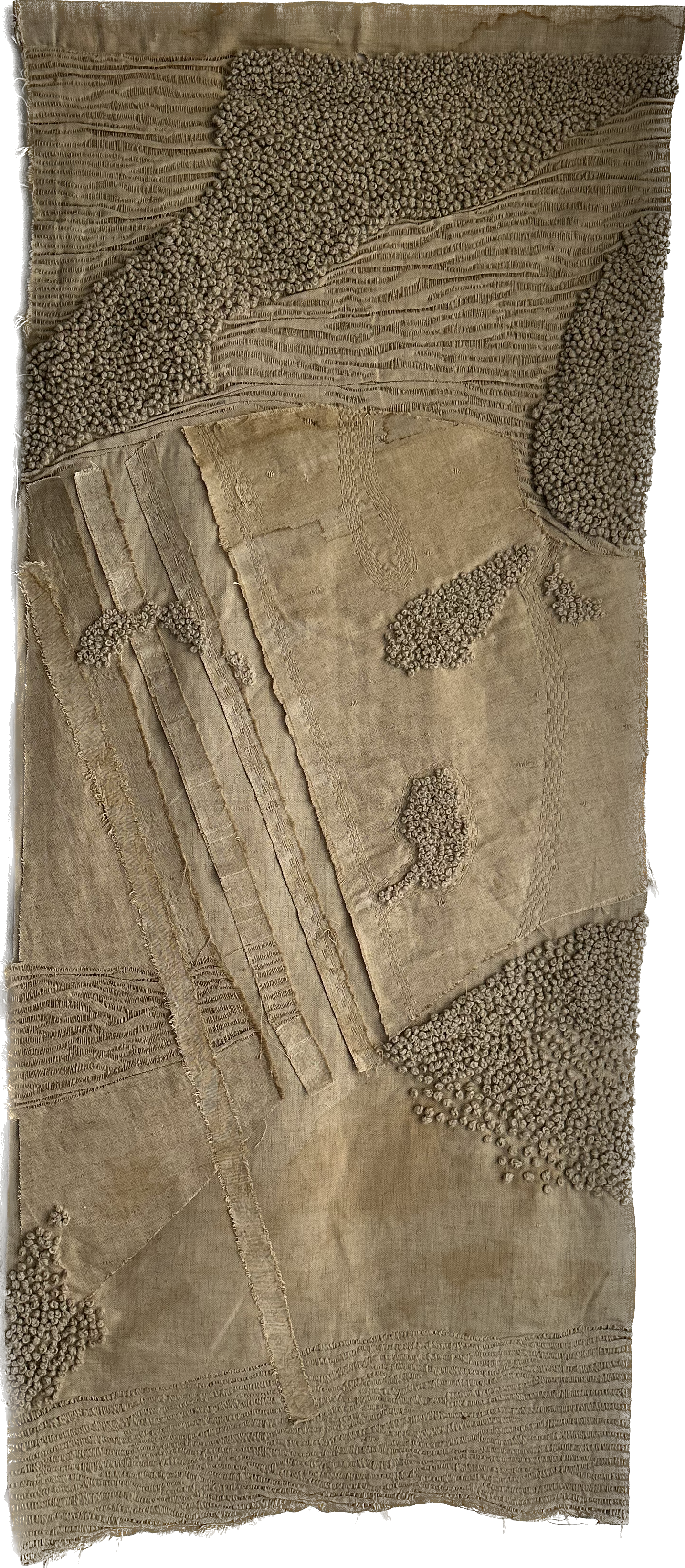Terra (In)cognita
2020, výšivka, textilná aplikácia, ľan, bavlna, vlna,
130 x 60 cm
Terra (In)cognita je textilné umelecké dielo, ktoré skúma premenu krajiny cez prizmu pamäti a osobnej geografie. Práca sa zaoberá priestormi, ktoré pretrvávajú z fyzického hľadiska, ale prešli významnými zmenami v charaktere v dôsledku síl urbanizácie a ekonomického rozvoja. Predtým otvorené polia, lúky a okrajové divoké terény postupne nahrádza priemyselná infraštruktúra, sklady a logistické zóny. Namiesto zobrazovania týchto miest reprezentatívnym spôsobom sa Terra (In)cognita zapája do subjektívneho procesu mapovania toho, čo zostáva zakorenené v pamäti.
Dielo využíva výšivku a vrstvenie textílií ako zámerné stratégie pomalej, stelesnenej dokumentácie. V tomto rámci funguje výšivka nielen ako dekoratívny alebo remeselný zásah, ale aj ako časovo intenzívna metóda záznamu a reflexie. Použitie prírodných materiálov, ako je ľan a vlna, je zámerné, podčiarkuje hmatový, organický charakter diela a posilňuje jeho koncepčný vzťah k nestálosti, krajine a plynutiu času.
Práca, umiestnená v rámci širších diskurzov súčasného vizuálneho umenia, sa zaoberá naliehavými problémami súvisiacimi s ekologickou degradáciou, priestorovým vymazaním a úlohou pamäte pri formovaní individuálnej aj kolektívnej identity.
Integrácia tradičných techník nie je zamýšľaná ako nostalgické gesto, ale ako reflexívne gesto – kvality, ako je pomalosť, materiálna prítomnosť a manuálna práca sú chápané ako jemné formy odporu voči zrýchleniu, dematerializácii a vizuálnej saturácii charakteristickej pre súčasnú kultúru.
V tomto kontexte možno dielo Terra (In)cognita chápať ako vizuálnu aj materiálnu odpoveď na zmiznutie známych krajín, ponúkajúcu zmyslovú, stelesnenú modalitu, prostredníctvom ktorej sa znovu zapojíte do prostredia, ktoré bolo zabudnuté, prepísané alebo štrukturálne transformované.
Dielo využíva výšivku a vrstvenie textílií ako zámerné stratégie pomalej, stelesnenej dokumentácie. V tomto rámci funguje výšivka nielen ako dekoratívny alebo remeselný zásah, ale aj ako časovo intenzívna metóda záznamu a reflexie. Použitie prírodných materiálov, ako je ľan a vlna, je zámerné, podčiarkuje hmatový, organický charakter diela a posilňuje jeho koncepčný vzťah k nestálosti, krajine a plynutiu času.
Práca, umiestnená v rámci širších diskurzov súčasného vizuálneho umenia, sa zaoberá naliehavými problémami súvisiacimi s ekologickou degradáciou, priestorovým vymazaním a úlohou pamäte pri formovaní individuálnej aj kolektívnej identity.
Integrácia tradičných techník nie je zamýšľaná ako nostalgické gesto, ale ako reflexívne gesto – kvality, ako je pomalosť, materiálna prítomnosť a manuálna práca sú chápané ako jemné formy odporu voči zrýchleniu, dematerializácii a vizuálnej saturácii charakteristickej pre súčasnú kultúru.
V tomto kontexte možno dielo Terra (In)cognita chápať ako vizuálnu aj materiálnu odpoveď na zmiznutie známych krajín, ponúkajúcu zmyslovú, stelesnenú modalitu, prostredníctvom ktorej sa znovu zapojíte do prostredia, ktoré bolo zabudnuté, prepísané alebo štrukturálne transformované.
Terra (In)cognita is a textile-based artwork that investigates the transformation of landscape through the prism of memory and personal geography. The work addresses spaces that persist in physical terms but have undergone significant shifts in character due to the forces of urbanization and economic development. Formerly open fields, meadows, and marginal wild terrains are progressively replaced by industrial infrastructure, warehouses, and logistics zones. Rather than depicting these sites in a representational manner, Terra (In)cognita engages in a subjective process of mapping what remains embedded in memory.
The piece employs embroidery and textile layering as deliberate strategies of slow, embodied documentation. Within this framework, embroidery functions not merely as a decorative or craft-based intervention, but as a temporally intensive method of recording and reflection. The use of natural materials such as linen and wool is intentional, underscoring the tactile, organic nature of the work and reinforcing its conceptual relationship to impermanence, landscape, and the passage of time.
Positioned within broader discourses in contemporary visual art, the work engages with pressing concerns related to ecological degradation, spatial erasure, and the role of memory in shaping both individual and collective identity.
The integration of traditional techniques is not intended as a nostalgic gesture, but as a reflective one—foregrounding qualities such as slowness, material presence, and manual labor as subtle forms of resistance to the acceleration, dematerialization, and visual saturation characteristic of contemporary culture.
In this context, Terra (In)cognita can be understood as both a visual and material response to the disappearance of familiar landscapes, offering a sensorial, embodied modality through which to re-engage with environments that have been forgotten, overwritten, or structurally transformed.
The piece employs embroidery and textile layering as deliberate strategies of slow, embodied documentation. Within this framework, embroidery functions not merely as a decorative or craft-based intervention, but as a temporally intensive method of recording and reflection. The use of natural materials such as linen and wool is intentional, underscoring the tactile, organic nature of the work and reinforcing its conceptual relationship to impermanence, landscape, and the passage of time.
Positioned within broader discourses in contemporary visual art, the work engages with pressing concerns related to ecological degradation, spatial erasure, and the role of memory in shaping both individual and collective identity.
The integration of traditional techniques is not intended as a nostalgic gesture, but as a reflective one—foregrounding qualities such as slowness, material presence, and manual labor as subtle forms of resistance to the acceleration, dematerialization, and visual saturation characteristic of contemporary culture.
In this context, Terra (In)cognita can be understood as both a visual and material response to the disappearance of familiar landscapes, offering a sensorial, embodied modality through which to re-engage with environments that have been forgotten, overwritten, or structurally transformed.
